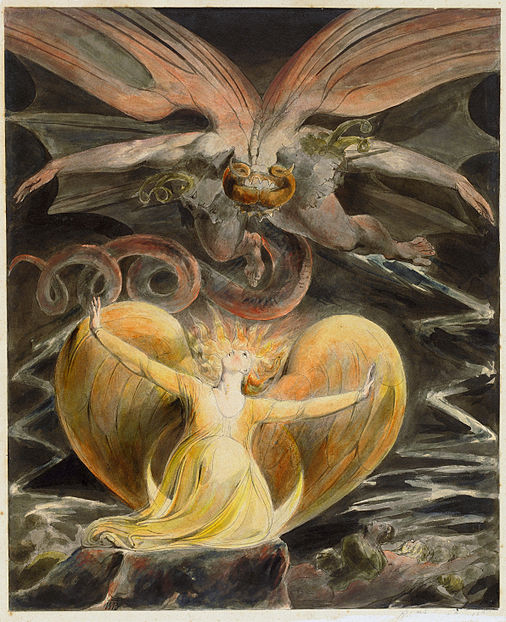
National Gallery
Washington DC
Courtesy of Wikimedia Commons
The Great Red Dragon and the Woman clothed with the Sun
Rev.12
[1] And there appeared a great wonder in heaven; a woman clothed with the sun, and the moon under her feet, and upon her head a crown of twelve stars:[2] And she being with child cried, travailing in birth, and pained to be delivered.
[3] And there appeared another wonder in heaven; and behold a great red dragon, having seven heads and ten horns, and seven crowns upon his heads.
[4] And his tail drew the third part of the stars of heaven, and did cast them to the earth: and the dragon stood before the woman which was ready to be delivered, for to devour her child as soon as it was born.
[5] And she brought forth a man child, who was to rule all nations with a rod of iron: and her child was caught up unto God, and to his throne.
[6] And the woman fled into the wilderness, where she hath a place prepared of God, that they should feed her there a thousand two hundred and threescore days.
[7] And there was war in heaven: Michael and his angels fought against the dragon; and the dragon fought and his angels,
[8] And prevailed not; neither was their place found any more in heaven.
[9] And the great dragon was cast out, that old serpent, called the Devil, and Satan, which deceiveth the whole world: he was cast out into the earth, and his angels were cast out with him.
In studying Blake one is led to give increasing attention to the multitude of symbols which he uses. The visual images which delight us with overall impressions and information, contain as well, clues to more subtle meaning through symbolic gestures. Janet A. Warner, in Blake's Visionary Forms Dramatic, edited by Erdman and Grant, wrote a chapter on Blake's use of gesture. We see repetitions of various postures and positions of the body in the images. Warner helps us to recognise how the gestures contribute to consolidating the symbolic language.
On page 187 Warner uses one image to demonstrate that details contribute to the overall themes conveyed in Blake's work:
"One design which uses many of the symbols which I have been discussing is the water color The Great Red Dragon and the Woman Clothed with the Sun. The hovering figure is here taken to its ultimate Satanic form, encompassing bat wings, serpent tail, and outstretched arms with downturned hands. According to Revelation the dragon is 'that old serpent, called the Devil, and Satan, which deceiveth the whole world.' The woman clothed in the sun and given the wings of an eagle represents the good in nature (she sits on the crescent moon) that the dragon is trying to vanquish; Blake indicates this also by her outstretched arms, her upturned hands, and her position on a stone in the sea, rather reminiscent of Urizen in America 8. The natural world of moon, stone and sea are her province, as they are his. Blake tells us how he reads the passage in Revelation, however, by the way the positions of the woman and the dragon reflect each other: these are two aspects of the same psyche, as powerful an image of the demonic and regenerative impulses of fallen man as he ever painted.
The symbolic gesture of outstretched arms, then, can be associated consistently with the main themes of Blake's work: the essential divinity of man, his capacity for regeneration, his error in turning the divine creativity into mental tyranny or selfhood. The importance of the four attitudes which repeatedly represent these ideas in Blake's art may remind us of his exclamation, 'What kind of Intellects must he have who sees only the Colours of things & not the Form of Things' [E 578]. The out stretched arms motif, perhaps the most evident of several of Blake's repeated visual images, should not, then, be ignored or dismissed as a technical weakness; it is as powerful as any verbal symbol, and essential to that union of sight and sound, that reintegration of the senses which Blake strove to achieve in all his work."
Public Address, PAGE 66, (E 578)
"The English Artist may be assured that he is doing an injury
& injustice to his Country while he studies & imitates the
Effects of Nature. England will never rival Italy while we
servilely copy. what the Wise Italians Rafael & Michael Angelo
scorned nay abhorred as Vasari tells us
Call that the Public Voice which is their Error
Like as a Monkey peeping in a Mirror
Admires all his colours brown & warm
And never once percieves his ugly form
What kind of Intellects must he have who sees only the Colours of
things & not the Forms of Things
PAGE 71
A jockey that is any thing of a jockey will never buy a
Horse by the Colour & a Man who has got any brains will never buy
a Picture by the Colour
When I tell any Truth it is Not for the sake of Convincing
those who do not know it but for the sake of defending those who
Do
PAGE 76
No Man of Sense ever supposes that Copying from Nature is
the Art of Painting if the Art is no more than this it is no
better than any others Manual Labour any body may do it & the
fool often will do it best as it is a work of no Mind"
Blake drew from his imagination using a vocabulary acquired through practice to express intellectual ideas. The form was primary but in spite of Blake's de-emphasis of its importance, the color was an additional facet of his symbolism.
No comments:
Post a Comment